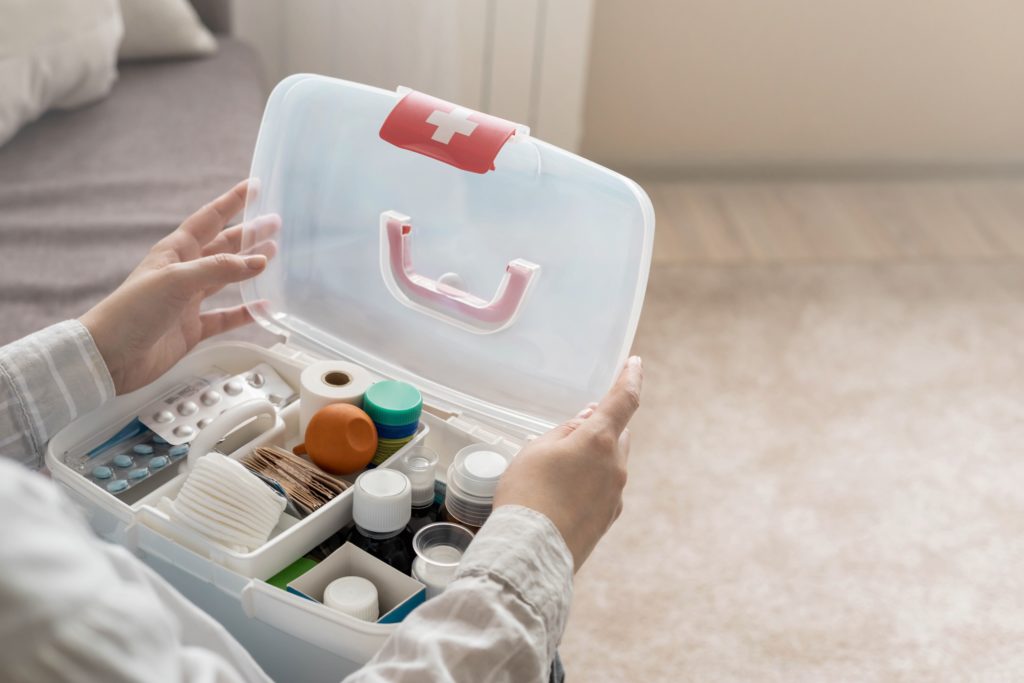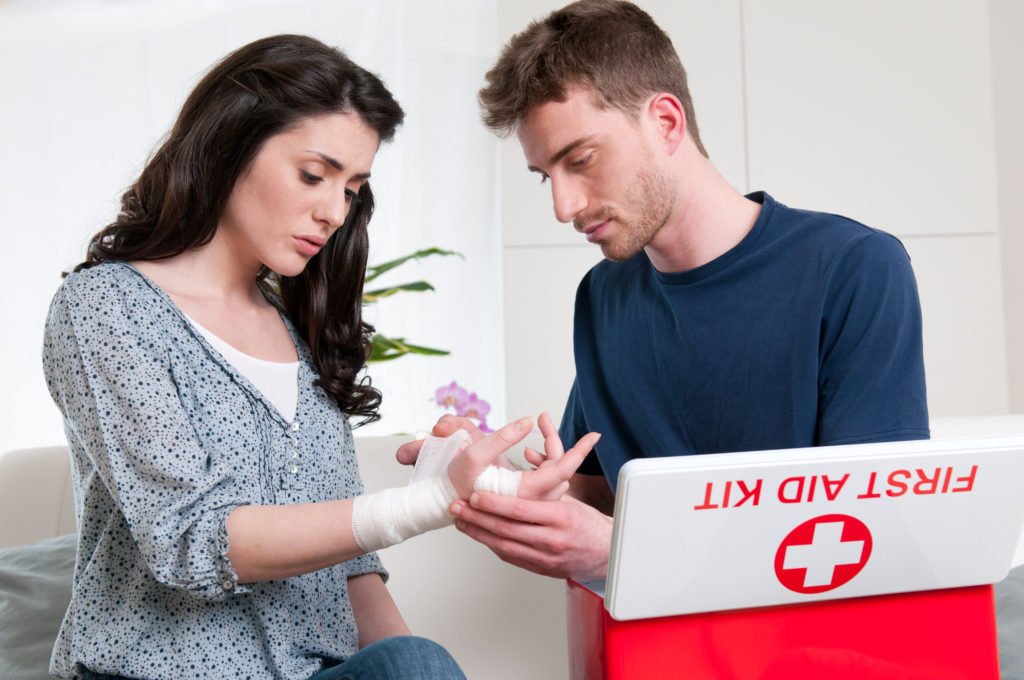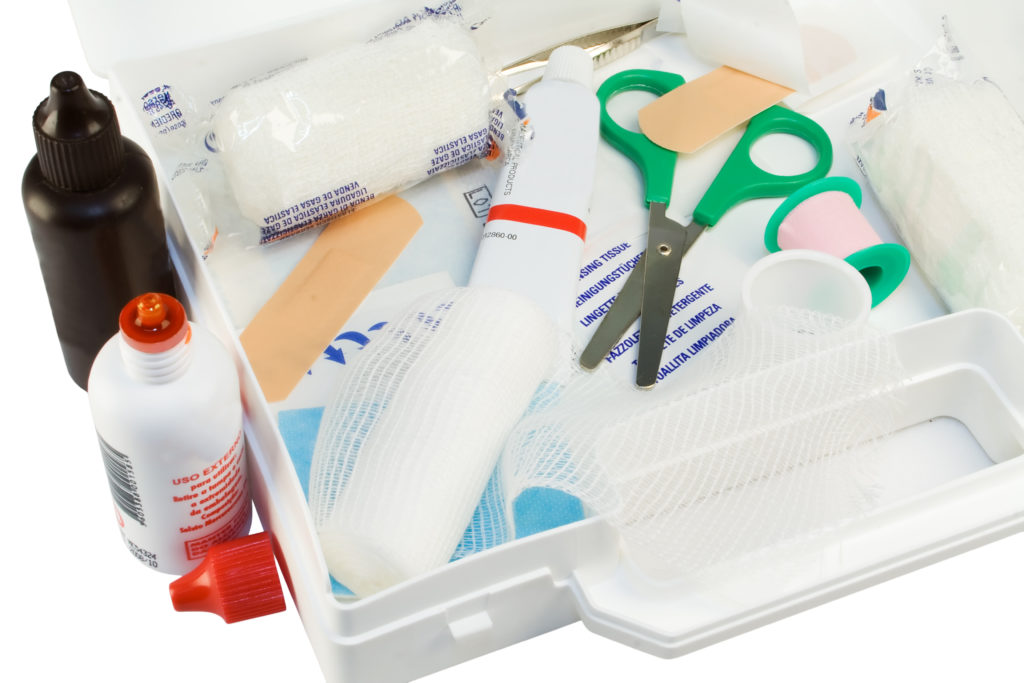February 28, 2023
22 Must-Haves for Your Emergency First-Aid Kit
You sliced your finger chopping veggies for a taco salad. Hubs got a nasty sunburn fishing on the lake. Tommy caught a shiner covering first base. Your mother-in-law started having chest pains during the family BBQ. And somehow your whole family got into poison oak on your weekend campout.
You don’t have to be a Boy Scout to know their “Be Prepared” motto makes a lot of sense. As sure as the Earth is spinning, a day will come when you, someone in your household, a friend, neighbor, teammate or complete stranger will need some kind of medical help. Having the necessary supplies on hand means you can handle minor injuries and help stabilize someone until emergency medical help arrives.
You don’t have to spend a lot of money on a pre-packaged first-aid kit. You can create your own. You can even customize it by adding things that may not come in a standard, store-bought kit. It’s smart to have one kit for your home and one in your car. Here’s how you can get started.
Step One: Pick Your Kit.
Choose waterproof plastic or soft nylon case large enough to hold your supplies. While you’re at it, get two. That way you can make one kit for your home and one to keep in the trunk of your car.
To handle the most common accidents, injuries and emergencies, here are 22 must-haves to stash in your first-aid kit.
1. Pain relievers. Ibuprofen, acetaminophen, naproxen, aspirin—they all do the trick when it comes to reducing pain and inflammation when someone is sick or injured.
2. Antihistamine – Along with relieving allergies, an antihistamine such as Benadryl tackles itching, sneezing, swelling and allergic reactions caused by mosquito and fire ant bites.
3. Dramamine – You may think of this as an over-the-counter med to relieve motion sickness, but it can help stop excessive vomiting and dehydration caused by vomiting.
4. Preparation H – Surprisingly, this ointment isn’t just for hemorrhoids. Its soothing ingredients reduce pain and inflammation caused by most kinds of burn—even sunburns. The cream is moisturizing so it prevents peeling, and even numbs pain since it is made with lidocaine.
5. Baby aspirin – If you or someone else is having chest pains, chew four baby aspirins. They can alleviate any blockage or blood clotting that may be causing the chest pains until emergency medical help arrives. Chew the aspirin, don’t swallow it. Chewing allows them to be absorbed into the bloodstream right away.
6. EpiPen – With fire ants, snakes, scorpions, wasps and so many other venomous creatures making Texas their home, an EpiPen can be a lifesaver. The pen has to be prescribed, so talk with your care provider. Make sure you check the pen’s expiration from time to time.
7. Narcan – Illegal fentanyl is making its way into every corner of America and overdose and deaths are skyrocketing. More people are losing a friend or family member to the opioid. Yet, one study found in most fentanyl deaths, “a bystander was nearby who could have helped prevent the death.” The Centers for Disease Control and Prevention recommend administering naloxone (Narcan). It’s available in pre-filled nasal spray form or as an injectable solution. When given in time, it can prevent death while waiting for medical help to arrive. Naloxone is commonly available without prescription at most pharmacies. The CDC says it is easy to use and doesn’t require medical training. Talk with your pharmacist if you have questions.
8. Glucose tablets, glucagon injection kit – If you or someone in your family live with diabetes, think about including these items—along with a juice box. Glucagon triggers the release of stored sugar, which raises blood sugar in the event of a severe hypoglycemic episode.
9. Sterile saline solution – Sure, you can use alcohol or hydrogen peroxide to wash out an open cut or gash, but sterile saline doesn’t sting! It can even be used to flush irritants from the eye.
10. Antibiotic ointment -There are so many name-brand and store-brand versions to choose from. Apply to wounds to prevent infection from setting in.
11. Steri strips – These small strips pull the skin together to keep a cut or wound from gaping open. They’re especially useful if you have small children.
 12. Bandages. It’s best to have a variety of sizes. The American Red Cross recommends keeping your kit stocked with 25 adhesive bandages of assorted sizes. They also suggest including a 3-inch-wide and 4-inch-wide gauze roller bandage.
12. Bandages. It’s best to have a variety of sizes. The American Red Cross recommends keeping your kit stocked with 25 adhesive bandages of assorted sizes. They also suggest including a 3-inch-wide and 4-inch-wide gauze roller bandage.
13. Gauze pads – Use these pads to apply pressure to an open wound and stop bleeding. You can also use them to make bandages.
14. Dermabond or superglue – Medical-grade Dermabond is a type of super glue used to close cuts. Since it can be expensive and hard to find, regular super glue works fine, too.
15. Tourniquet – Blood loss is the biggest risk with any nasty cut or gash. Tying a tourniquet tightly above the wound will stop or slow blood loss until you can get help. Medical-grade tourniquets are available at the drug store, but a thick string, small rope or man’s tie will all work in an emergency.
16. Ace wrap – Stabilize an ankle sprain or fracture with an ace wrap. Used with gauze pads, you can even use the wrap to form a bandage.
17. Orajel – Injuries to the tooth can be painful. Having this gel on hand allows you to safely numbs the pain. You may also want to include dental wax in case someone’s tooth gets knocked out. The wax holds the tooth in its socket and protects sensitive nerve endings until you can see a dentist who can, hopefully, save the tooth.
18. Scissors and tweezers – Both come in handy when you need to cut away clothing to treat a wound, shorten the length of an ace wrap and remove splinters or thorns from someone’s skin.
19. Disposable medical gloves and masks – Keep a box of each in your kit and wear them when treating injuries.
20. Waterproof flashlight, spare batteries, glow sticks – Important additions to help you find your way in the dark and locate other members of your party in a night-time emergency.
21. Bottled water, protein bars – Staying hydrated and fueled is important in an emergency situation. Keep both in your traveling emergency kit stashed in the trunk of your car.
22. Blanket. A space blanket comes in handy during sudden temperature drops and to help individuals who have suffered a trauma and may be going into shock.
Along with the above items, include emergency numbers in your first aid kit, along with the name of your family’s doctor, a list of family members’ medical conditions and any current medications.
Remember, a first aid kit is designed to help you deal with an injury until you can seek proper medical attention.
Sources: First-aid Kits: Stock Supplies That Can Save Lives, Mayo Clinic, 2022; Must-Haves for Your First-Aid Kit, Centers for Disease Control and Prevention, 2021; The Glucagon Emergency Kit Is Ready When You Need It, Glucagon Emergency Kit, 2023; Make a First-Aid Kit, Red Cross, 2023; What Should Be in a Home First Aid Kit, UC San Diego Health, 2017; Fentanyl, Centers for Disease Control and Prevention, 2022; Now Is the Time to Stope Overdose Deaths, Centers for Disease Control and Prevention, 2022;
8 Surprising Uses for Hemorrhoid Cream, Healthgrades, 2021.
DISCLAIMER
The information featured in this site is general in nature. The site provides health information designed to complement your personal health management. It does not provide medical advice or health services and is not meant to replace professional advice or imply coverage of specific clinical services or products. The inclusion of links to other web sites does not imply any endorsement of the material on such websites.